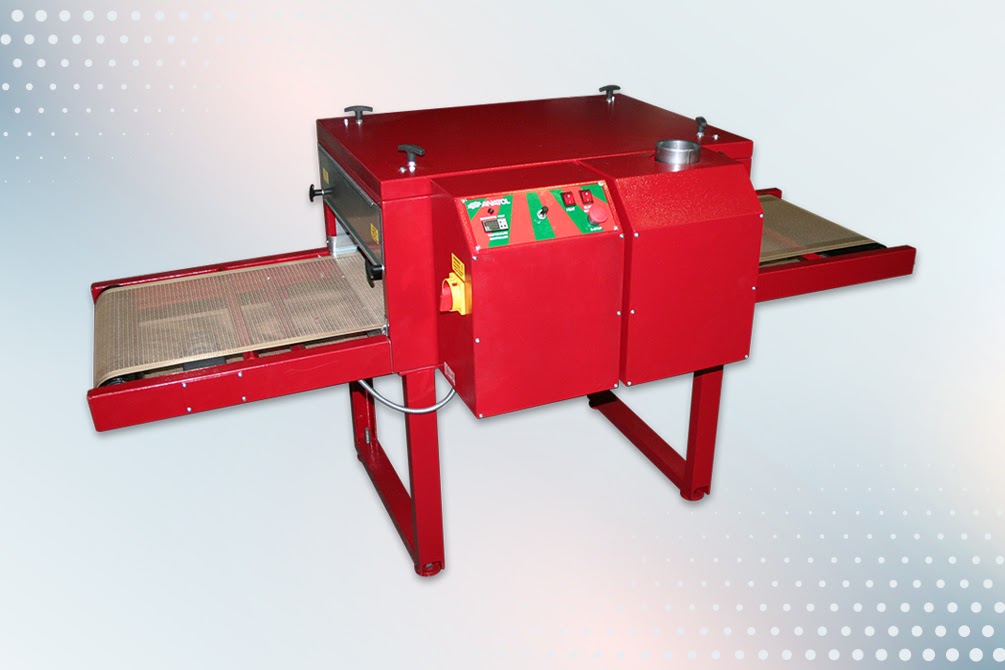Curing is a simple but the most used process of the printing phase. It is not only about choosing the right flash curing unit. But, it includes working with different dryers to carry out the drying process. Most of the print owners use either; gas dryers or electric dryers. Depending on the usage print owners buy either of them. Without the drying process your fabric is very likely to fade and lose the prints.
Electric dryers are useful when working with plastisol inks whereas gas dryers are useful when working with water-based ink or needs high volume printing. Each of them has a purpose to serve. Most of the print owners are confused about which one is better and what things one must consider while purchasing conveyor belt dryer screen printing. Thus, in this article, I will discuss conveyor dryers in detail and see in detail things you must consider when purchasing them.
Without, a further ado, let’s start:
Types of Conveyor Dryer:
There are multiple types of conveyor dryers involved in the print process. Depending on your use, you need to define which one you want to use. Let us see each of them in brief:
Gas Dryers:
Gas dryers are often the first choice of many print owners because it provides ease during the curing process. One of the major advantages of gas dryers is that they maintain the temperature and avoid the overheating issue.
In gas dryers, the heat dries the chamber via the convection process and prevents the other garments from the damage. Another major advantage is it is energy efficient and saves up to 30% of energy. Initially, it might be a bit costly but will be worth it for your company.
The gas dryers have an open flame which heats the air within the chamber and transfers the heated air towards the garment area via air convection. The process of drying is so simple that often gas dryers end up being the first choice for screen printing conveyor dryers.
Electric Dryers:
Electric dryer uses infrared radiation which causes ink molecules to vibrate and generate heat. This will raise the temperature of ink rapidly without heating the air around it. Electric dryers are small and less expensive compared to gas dryers because they do not need insulation and less dwell time. Additionally, infrared radiation uses ink curing temperature rapidly and efficiently especially while using plastisol inks. But, in many cases, if the infrared dryer is slow then the ink can overheat and break down.
While using an electric dryer, if you use a three-phase power supply, it will help you to save time and money.
When you are planning to choose the conveyor dryer for curing purposes, decide it; depending on the ink type, garment material, average production rate, and more.
Sell more with customizable products. Make online shopping experience engaging with product customization as an added USP!
Going further, let’s see discuss certain things to take into consideration while purchasing conveyor dryer for screen printing:
How to Choose the Right Screen Printing Dryers:
Check the Size of your Shop:
Size of the shop has an important role to play while deciding the screen printing conveyor dryer. Screen printing dryers are available in varied sizes like 6, 8, 10, and 12 inches and have different belt speeds from 24” to 84”. But, you need to first look at your shop’s size and then decide which one is perfect for your shop. Another thing you need to check is the number of orders and production rate you get. Depending on this, you need to define the type of the conveyor dryer you want to have.
Remember, the size of the machine will impact your production rate and can either make it slow or fast. Additionally, if you are planning to expand your production then having a broader conveyor dryer is important.
If you are using the screen printing conveyor dryer for commercial purpose then aim to use the larger dryer as the length and width of the dryer has a vital role to play and affects the productivity.
Decide Size Depending on the Workflow:
Workflow and daily average production influences your decision on the size of the machine you want to buy. If your daily production rate is too high then you need to have a large machine size as it will make the production rate faster.
If your daily average production is more than 50% and if your existing conveyor dryer is making the process slow, split-belt conveyor dryers can come to your rescue. Split-belt dryer is when two belts are running independently in the heating chamber i.e. it works like a two heating machine in one machine.
Airflow around Conveyor Dryer:
When curing an ink many factors have an impact. Be it dryer or a surrounding airflow. The t-shirt type or the ink you are using for screen-printing too has an impact, airflow is an essential factor. The good air movement prevents the t-shirt from scorching and burning issues. A good strong airflow accelerates the drying of printed t-shirts.
Conveyor belt dryer screen printing is also good for DTG printing and airflow is suitable for t-shirts for ink to dry and last longer. But, if you are using plastisol inks then you will need 320 degrees Fahrenheit to dry. Whereas, in DTG and water-based inks it is easy to remove moisture using airflow.
Pro-tip: Better the dryer airflow, efficiently it cures the t-shirt.
Gas or Electric Dryer:
This is the most common question about which type of dryer you must use. Before you make any decision remember to understand them in detail. You need to understand the resources you will need to support various types of machines. If you are printing using multiple inks like plastisol, water-based ink, or DTG inks, gas conveyor dryers is the best option. Most of the gas conveyors are designed for large production and mostly used for commercial purposes. It has an average length of 20 feet and needs a larger shop size.
Environmental Facility:
One of the major things to consider is the impact of the dryer on the environment. If the material or the equipment has a negative impact on the environment then it won’t be good for your business. There can be chances of the material being flammable and having high-risks of fire or explosion. Thus, while choosing the right type of the material you need to keep it safe, clean, and contaminant free. Remember while choosing the conveyor dryer for screen printing you cannot take any chances.
Cost:
While selecting the conveyor dryer for screen printing, cost has a vital role to play. It will also be one of the major concerns and can influence your decision. You will need to define your budget, do proper research on various types of conveyor dryers, and then pick the one you want which suffices your requirements.
Make sure to not go for too cheap brands too as it might cost you a lot of money in the long run. Choose the brand which adds up a proper value to your work, you get timely service, and fast production rate.
Difference between Gas and Electric Dryer:
Gas and electric dryers are unique in their own way and are mandatory in your business. Gas dryers are useful for large productions and mainly for water-based inks and high volume printing whereas electric dryers are used mostly with plastisol inks.
If sustainability is one of the major concerns for you then a gas dryer is your answer. They save up to 30% of energy. On the other hand, if you are using a three phase power supply in an electric dryer then it can help you with saving some amount of energy.
Another major difference between them is cost. If you are a startup company and need to save some amount of money then an electric dryer is a perfect option. It is a bit cheaper than a dryer and can help save energy too. Whereas, if money is not a major concern and you can do heavy investment then you can purchase a gas dryer.
Launch Web to Print Store now! Start selling personalized products with a brand new website.
Pros and cons of Gas and Electric Dryer:
Like each dryer, even gas and electric dryers have their pros and cons. Here are some of them to help you make better decisions:
Pros of Gas Dryer:
- Gas dryers save 30% more on energy costs.
- It provides air circulation for curing
- It is suitable for various garments like polyester and heat sensitive garments
- It prevents scorching and burning of fabric
- It is also suitable for curing water-based and DTG inks
- Avoids overheating on ink
Cons of Gas Dryer:
- More expensive than electric dryer
- Not suitable for plastisol ink applications
- It needs longer time to dry which consumes more energy and increases expenditure
Pros of Electric Dryer:
- The electric dryers are less expensive than gas dryers
- They are quick and directly heat the fabric.
- Best solution for plastisol inks
- Cost-effective if you are using three-phase electric supply
Cons of electric dryers:
- It ignores the air circulation and is important for curing
- Due to air circulation, electric dryers are not suitable for dry-fit polyester, or heat sensitive fabric
- Garment might get scorched because of poor air circulation
- It is not suitable for water-based and DTG inks
Which one to Choose:
This is the most common question asked by print owners as both of the conveyor dryers are best in their own ways. To overcome such a dilemma you need to first understand the major differences between them. Further, depending on your business needs, you can define which screen printing dryer you prefer.
If you need to spend less and get the best results then an electric dryer is your answer. On the other hand, if cost is not a major concern for you and you need a fast production rate then going for the gas dryer can be your answer. Both the dryers are best in their own way and have a purpose to serve. Choose the one depending on your needs and production requirements.
Conclusion:
Don’t even think of excluding conveyor belt dryer screen printing from your t-shirt printing phase. They are very important for your printing process and help in making ink last longer. The correct dryer helps you to cure your ink and have better return on investments.
Apart from dryers, if you are facing problems in understanding customers’ requirements, last minute changes in designs, and unnecessary back and forth communications then we have a solution for you.
Product Design Tool by PrintXpand
Our Product Designer Tool will provide your customers with the freedom to create their own designs, have 3D preview before placing orders, and decrease your workload. They can use our feature-rich tool and create their own designs. Our industry experts have helped more than 80+ clients to start their web-to-print store have helped them serve their customers better. Curious to know more about our Designer Tool? Just one click, and we will provide you a personalized tour of our product.
All product and company names are trademarks™, registered® or copyright© trademarks of their respective holders. Use of them does not imply any affiliation with or endorsement by them.


![5 Benefits of Selling Custom Photo Albums [Bonus: How to Sell] blog img](https://www.printxpand.com/wp-content/uploads/2023/05/Albums-Feature-Image-40421.jpg)

